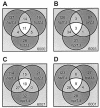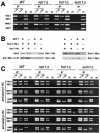NAD+-dependent deacetylase Hst1p controls biosynthesis and cellular NAD+ levels in Saccharomyces cerevisiae
- PMID: 12972620
- PMCID: PMC193940
- DOI: 10.1128/MCB.23.19.7044-7054.2003
NAD+-dependent deacetylase Hst1p controls biosynthesis and cellular NAD+ levels in Saccharomyces cerevisiae
Abstract
Nicotine adenine dinucleotide (NAD(+)) performs key roles in electron transport reactions, as a substrate for poly(ADP-ribose) polymerase and NAD(+)-dependent protein deacetylases. In the latter two processes, NAD(+) is consumed and converted to ADP-ribose and nicotinamide. NAD(+) levels can be maintained by regeneration of NAD(+) from nicotinamide via a salvage pathway or by de novo synthesis of NAD(+) from tryptophan. Both pathways are conserved from yeast to humans. We describe a critical role of the NAD(+)-dependent deacetylase Hst1p as a sensor of NAD(+) levels and regulator of NAD(+) biosynthesis. Using transcript arrays, we show that low NAD(+) states specifically induce the de novo NAD(+) biosynthesis genes while the genes in the salvage pathway remain unaffected. The NAD(+)-dependent deacetylase activity of Hst1p represses de novo NAD(+) biosynthesis genes in the absence of new protein synthesis, suggesting a direct effect. The known Hst1p binding partner, Sum1p, is present at promoters of highly inducible NAD(+) biosynthesis genes. The removal of HST1-mediated repression of the NAD(+) de novo biosynthesis pathway leads to increased cellular NAD(+) levels. Transcript array analysis shows that reduction in cellular NAD(+) levels preferentially affects Hst1p-regulated genes in comparison to genes regulated with other NAD(+)-dependent deacetylases (Sir2p, Hst2p, Hst3p, and Hst4p). In vitro experiments demonstrate that Hst1p has relatively low affinity toward NAD(+) in comparison to other NAD(+)-dependent enzymes. These findings suggest that Hst1p serves as a cellular NAD(+) sensor that monitors and regulates cellular NAD(+) levels.
Figures





References
-
- Anderson, R. M., K. J. Bitterman, J. G. Wood, O. Medvedik, H. Cohen, S. S. Lin, J. K. Manchester, J. I. Gordon, and D. A. Sinclair. 2002. Manipulation of a nuclear NAD+ salvage pathway delays aging without altering steady-state NAD+ levels. J. Biol. Chem. 277:18881-18890. - PubMed
-
- Bitterman, K. J., R. M. Anderson, H. Y. Cohen, M. Latorre-Esteves, and D. A. Sinclair. 2002. Inhibition of silencing and accelerated aging by nicotinamide, a putative negative regulator of yeast sir2 and human SIRT1. J. Biol. Chem. 277:45099-45107. - PubMed
Publication types
MeSH terms
Substances
Grants and funding
LinkOut - more resources
Full Text Sources
Molecular Biology Databases
